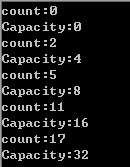[c#基础]集合foreach的必要条件和自定义集合
引言
最近翻看了之前的学习笔记,看到foreach,记得当时老师讲的时候,有点犯浑,不是很明白,这好比,上小学时,你不会乘法口诀,但是随着时间的增长,你不自觉的都会了,也悟出个小道理,有些东西,你当时不太懂,但随着你的阅历和经验的增长,有那么一天你会恍然大悟,哦,原来是这样。
自定义集合类
提到foreach就不得不说集合,那么就先从自定义的集合开始吧。
using System;
using System.Collections.Generic;
using System.Linq;
using System.Text;
using System.Threading.Tasks; namespace Wolfy.自定义集合
{
/// <summary>
/// 自定义集合类
/// </summary>
public class MyArrayList
{
/// <summary>
/// 集合的容量属性 成倍数增加0,4,8,且只读
/// </summary>
public int Capacity
{
get
{
return this.objArray.Length == ? : this.index > this.objArray.Length ? this.objArray.Length * : this.objArray.Length;
}
}
/// <summary>
/// 集合实际元素个数 且只读
/// </summary>
public int Count
{
get
{
return this.index;
}
}
private int index;
private object[] objArray;
public MyArrayList()
{
index = ;
//初始化0长度的数组
this.objArray = new object[];
}
/// <summary>
/// 添加元素
/// </summary>
/// <param name="value">元素值</param>
public void Add(object value)
{
if (index >= this.objArray.Length)
{
object[] newArray = index == ? new object[this.objArray.Length + ] : new object[this.objArray.Length * ];
objArray.CopyTo(newArray, );
objArray = newArray;
objArray[index++] = value;
}
else
{
objArray[index++] = value;
}
}
/// <summary>
/// 添加数组
/// </summary>
/// <param name="objs"></param>
public void AddRange(object[] objs)
{
for (int i = ; i < objs.Length; i++)
{
this.Add(objs[i]);
}
}
}
}
不知道自定义的集合和ArrayList是否一样,可以简单的测试一下。
using System;
using System.Collections;
using System.Collections.Generic;
using System.Linq;
using System.Text;
using System.Threading.Tasks; namespace Wolfy.自定义集合
{
class Program
{
static void Main(string[] args)
{
ArrayList list = new ArrayList();
//MyArrayList list = new MyArrayList();
Console.WriteLine("count:" + list.Count);
Console.WriteLine("Capacity:" + list.Capacity);
list.Add();
list.Add();
Console.WriteLine("count:" + list.Count);
Console.WriteLine("Capacity:" + list.Capacity);
list.Add();
list.Add();
list.Add();
Console.WriteLine("count:" + list.Count);
Console.WriteLine("Capacity:" + list.Capacity);
list.Add();
list.Add();
list.Add();
list.Add();
list.Add();
list.Add();
Console.WriteLine("count:" + list.Count);
Console.WriteLine("Capacity:" + list.Capacity);
object[] arr = { , , , , , };
list.AddRange(arr);
Console.WriteLine("count:" + list.Count);
Console.WriteLine("Capacity:" + list.Capacity);
Console.Read();
}
}
}
此时是.Net中的ArrayList,结果:
自定义的集合,结果:

输出结果一样,那么现在用foreach遍历,自定义集合中的元素。F6编译,会提示错误。

foreach语句
其实foreach是怎样工作的呢?
众所周知foreach中in后面的对象应该是实现IEnumerable接口的,程序运行时本质是在调用IEnumerable的GetEnumerator函数来返回一个IEnumerator对象,foreach就是利用IEnumerator对象的Current,MoveNext和Reset成员来进行一段数据的枚举。简单的代码实现如下:
//System.Collections下的IEnumerator
IEnumerator enumerator = this.objArray.GetEnumerator();
while (enumerator.MoveNext())
{
Console.WriteLine(enumerator.Current);
}
将这个代码放在自定义集合中,定义一个方法GetArray(),然后测试一下
/// <summary>
/// 得到所有的元素
/// </summary>
public void GetArray()
{
//System.Collections下的IEnumerator
IEnumerator enumerator = this.objArray.GetEnumerator();
while (enumerator.MoveNext())
{
Console.Write(enumerator.Current+“,”);
}
}
测试结果:

你运行会发现多出很多逗号,原因是执行后,enumerator没有被Dispose掉,而继承IDisposable的迭代器(IEnumerator)在foreach结束后会被正确处理掉(调用Dispose方法)。
自定义集合实现IEnumerable接口
实现IEnumerable接口必须实现它里面的成员GetEnumerator()方法:
public IEnumerator GetEnumerator()
{
throw new NotImplementedException();
}
该方法的返回值为实现了IEnumerator接口的类的对象。那么现在需要定义一个实现了该接口的类。
using System;
using System.Collections;
using System.Collections.Generic;
using System.Linq;
using System.Text;
using System.Threading.Tasks; namespace Wolfy.自定义集合
{
public class MyEnumerator : IEnumerator
{
/// <summary>
/// 返回当前指针指向的元素的值
/// </summary>
public object Current
{
get { throw new NotImplementedException(); }
}
/// <summary>
/// 将指针向前移动1位,并判断当前位有没有元素.指针默认在-1位置
/// </summary>
/// <returns></returns>
public bool MoveNext()
{
throw new NotImplementedException();
}
/// <summary>
/// 重置
/// </summary>
public void Reset()
{
throw new NotImplementedException();
}
}
}
迭代需要数组参数,在构造函数中将自定义集合中的数组传进来,并且在MoveNext中需要判断指针是否移动到数组的末尾,那么需要数组的长度。
MyArrayList中GetEnumerator()方法实现
public IEnumerator GetEnumerator()
{
return new MyEnumerator(this.objArray, this.Count);
}
MyEnumerator类
using System;
using System.Collections;
using System.Collections.Generic;
using System.Linq;
using System.Text;
using System.Threading.Tasks; namespace Wolfy.自定义集合
{
public class MyEnumerator : IEnumerator
{
/// <summary>
/// 指针的默认位置
/// </summary>
private int index = -;
private object[] objArray;
/// <summary>
/// 数组长度
/// </summary>
private int count;
public MyEnumerator(object[] objArray, int count)
{ this.objArray = objArray;
this.count = count;
}
/// <summary>
/// 返回当前指针指向的元素的值
/// </summary>
public object Current
{
get { return this.objArray[index]; }
}
/// <summary>
/// 将指针向前移动1位,并判断当前位有没有元素.指针默认在-1位置
/// </summary>
/// <returns></returns>
public bool MoveNext()
{
index++;//指针首先向前移动一位
if (index < this.count)
{
return true;
}
else
{
return false;
}
}
/// <summary>
/// 重置
/// </summary>
public void Reset()
{
index = -;
}
}
}
测试,foreach语句,然后编译不再报错,说明已经成功了,结果如下:

这次后边不会多出逗号,原因实现了迭代器接口而迭代器继承自IDisposable接口,最后调用了Dispose()方法
代码下载,请戳这里:http://pan.baidu.com/s/1pJsGyHt
总结
foreach遍历in后面的对象需实现IEnumerable接口。
迭代器概念可参考:http://msdn.microsoft.com/zh-cn/library/dscyy5s0(VS.80).aspx
东西比较基础,以上是个人理解,如理解有误,请指正,以免误人子弟。
[c#基础]集合foreach的必要条件和自定义集合的更多相关文章
- 集合、拆箱、装箱、自定义集合的foreach
集合部分 参考:http://msdn.microsoft.com/zh-cn/library/0ytkdh4s(v=vs.110).aspx 集合类型是诸如哈希表.队列.堆栈.包.字典和列表等数据集 ...
- 使用yield关键字让自定义集合实现foreach遍历
一般来说当我们创建自定义集合的时候为了让其能支持foreach遍历,就只能让其实现IEnumerable接口(可能还要实现IEnumerator接口) 但是我们也可以通过使用yield关键字构建的迭代 ...
- C# 通过IEnumberable接口和IEnumerator接口实现自定义集合类型foreach功能
1.IEnumerator和IEnumerable的作用 其实IEnumerator和IEnumerable的作用很简单,就是让除数组和集合之外的类型也能支持foreach循环,至于foreach循环 ...
- C# 通过IEnumberable接口和IEnumerator接口实现泛型和非泛型自定义集合类型foreach功能
IEnumerator和IEnumerable的作用 其实IEnumerator和IEnumerable的作用很简单,就是让除数组和集合之外的类型也能支持foreach循环,至于foreach循环,如 ...
- 《C#本质论》读书笔记(16)构建自定义集合
16.1 更多集合接口 集合类(这里指IEnumerable层次结构)实现的接口层次结构 16.1.1 IList<T>与IDictionary<TKey,TValue> 字典 ...
- 十六、C# 常用集合类及构建自定义集合(使用迭代器)
常用集合类及构建自定义集合 1.更多集合接口:IList<T>.IDictionary<TKey,TValue>.IComparable<T>.ICollectio ...
- Android零基础入门第42节:自定义BaseAdapter
原文:Android零基础入门第42节:自定义BaseAdapter 在ListView的使用中,有时候还需要在里面加入按钮等控件,实现单独的操作.也就是说,这个ListView不再只是展示数据,也不 ...
- 实现自定义集合的可枚举类型(IEnumerable)和枚举数(IEnumerator )
下面的代码示例演示如何实现自定义集合的 IEnumerable 和 IEnumerator 接口: using System; using System.Collections; using Syst ...
- Map集合的遍历方式以及TreeMap集合保存自定义对象实现比较的Comparable和Comparator两种方式
Map集合的特点 1.Map集合中保存的都是键值对,键和值是一一对应的 2.一个映射不能包含重复的值 3.每个键最多只能映射到一个值上 Map接口和Collection接口的不同 Map是双列集合的根 ...
随机推荐
- jenkins 更换主数据目录
工作中,由于Jenkins默认的主目录空间太小,导致需要将Jenkins默认的主目录修改到其它目录.本文针对更改Jenkins的主目录详细介绍. 注意:在Jenkins运行时是不能更改的. 请先将Je ...
- Hadoop学习之SecondaryNameNode
在启动Hadoop时,NameNode节点上会默认启动一个SecondaryNameNode进程,使用JSP命令可以查看到.SecondaryNameNode光从字面上理解,很容易让人认为是NameN ...
- Hadoop_HDFS架构和HA机制
Hadoop学习笔记总结 01.HDFS架构 1. NameNode和ResourceManager NameNode负责HDFS,从节点是DataNode:ResourceManager负责MapR ...
- 1644 免费馅饼 题解(c++)(S.B.S.)
1644 免费馅饼(巴蜀oj上的编号) 题面: SERKOI最新推出了一种叫做“免费馅饼”的游戏. 游戏在一个舞台上进行.舞台的宽度为W格,天幕的高度为H格,游戏者占 ...
- 【OpenGL】交互式三次 Bezier 曲线
1. 来源 三次贝塞尔曲线就是依据四个位置任意的点坐标绘制出的一条光滑曲线 2. 公式 3. 实现 #include <iostream> #include <math.h> ...
- UVA 11573 Ocean Currents --BFS+优先队列
采用优先队列做BFS搜索,d[][]数组记录当前点到源点的距离,每次出队时选此时eng最小的出队,能保证最先到达的是eng最小的.而且后来用普通队列试了一下,超时..所以,能用优先队列的,就要用优先队 ...
- SGU 180 Inversions
题意:求逆序数对数量. 思路一:暴力,O(N^2),超时. 思路二:虽然Ai很大,但是n比较小,可以离散化,得到每个Ai排序后的位置Wi,然后按照输入的顺序,每个Ai对答案的贡献是Wi-Sum(Wi- ...
- SSO - 我们为何需要单点登录系统
SSO,Single Sign On,也就是单点登录,保证一个账户在多个系统上实现单一用户的登录 现在随着网站的壮大,很多服务会进行拆分,会做SOA服务,会使用dubbo做微服务,或者简单的小型分布式 ...
- Android Activity的生命周期
一.为什么要了解Activity的生命周期 activity is directly affected by its association withother activities, its tas ...
- Mac上安装node.js
1.下载node for mac并一路默认安装 2.测试成功否 3.copy this file to test(save as javascript file) var http = require ...
